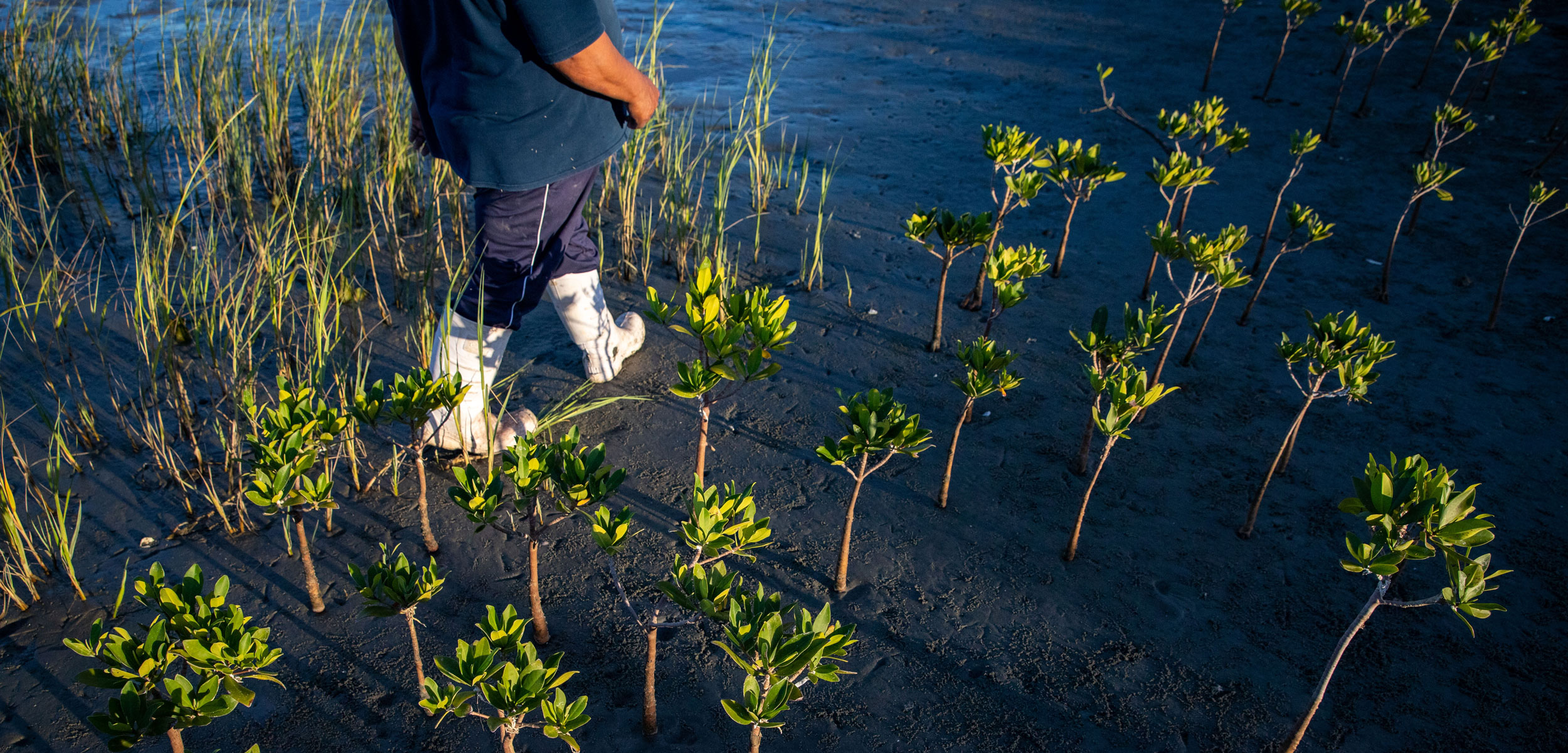The Mangrove Grandparents of El Delgadito
For over a decade, Ana María and David have led their community to restore Mexico’s desert mangroves with dedication, experimentation, and plenty of heart.
Article body copy
The sun sits low in the sky as David Borbón walks from one young mangrove to another, treading carefully so as not to disturb their roots. A golden glow lights the plants as he delicately checks for flowers and new growth, removing strands of dried algae and seagrass that accumulate on the saplings with the coming and going of tides. Every so often, he lets out a joyful cry upon finding a new propagule—a small, green bean–shaped seedling—growing on a tree he has planted: “My grandchild!” He takes out his phone to capture a picture of the new family member. It has taken him over a decade to get to this moment—a shoreline filled with thriving mangroves where before there was only sand—his devotion to his work unwavering.
Back in his boat, we slowly navigate the narrow channels from Borbón’s mangroves to his nearby home in the small fishing community of Campo Delgadito, mindful of our course with the dropping tide. Shorebirds scurry on the exposed mudflats, digging for their next meal. Situated on the Pacific coast about halfway down the peninsula of Baja California, Mexico, El Delgadito—“the little narrow one”—is a long spit of land jutting northwest into the mouth of Laguna San Ignacio. It’s home to 54 permanent residents, with up to 85 inhabitants during the most important fishing seasons.

White pelicans rest on a sandbar exposed at low tide. Behind them, scores of shorebirds forage for food. Over 200 bird species have been identified in Laguna San Ignacio, representing almost half of all the species found in the state of Baja California Sur, Mexico. The mangroves serve as excellent resting places and feeding grounds for many of these species.
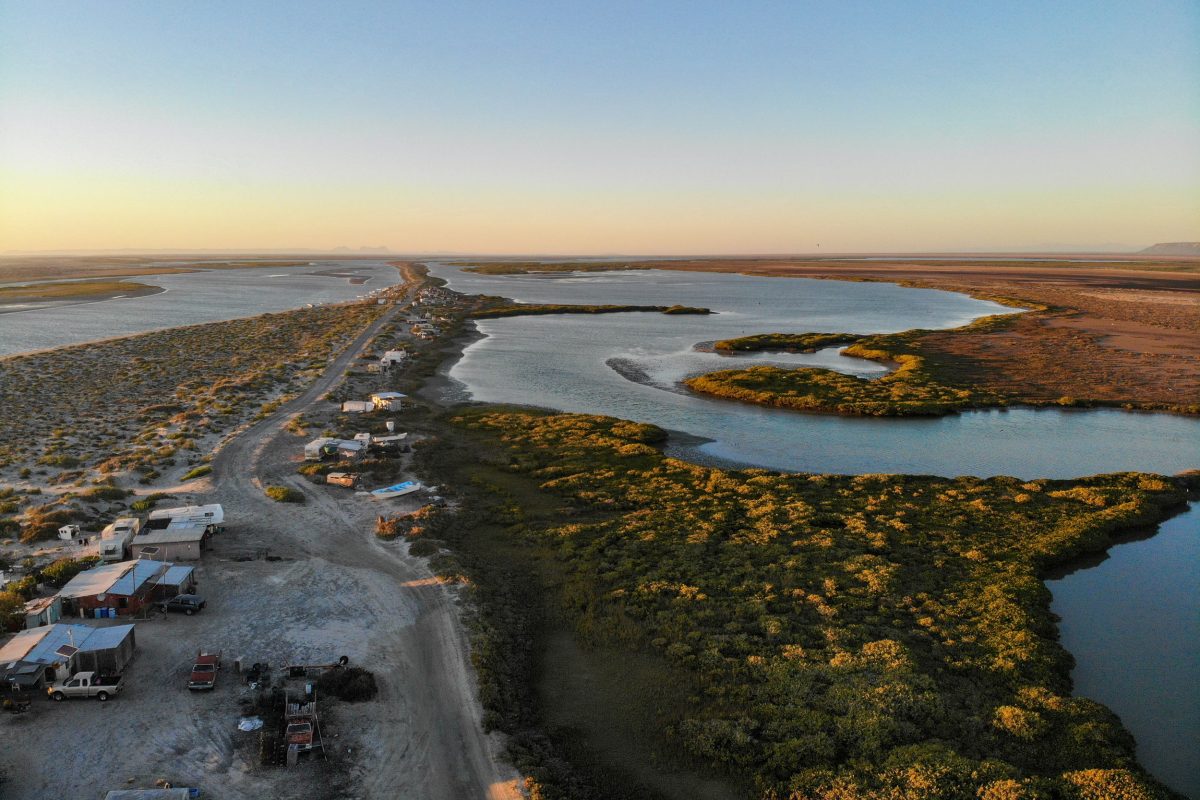
To the left of Campo Delgadito, Mexico, lies the Pacific Ocean and many of the small islets where David Borbón focuses his work. On its right, mangroves grow right up and into residents’ backyards. The community is located at the southern entrance of Laguna San Ignacio, part of the Whale Sanctuary of El Vizcaíno. The sanctuary is an important site for gray whales during their birthing and breeding season and is a UNESCO World Heritage Site.
Borbón first arrived in El Delgadito as a young man in 1980, and he returned seasonally for the fishing—lobster, sea bass, halibut, and clams. “[Back then], mangroves were just branches that were in the way of navigating to go fishing. I didn’t have the slightest idea of their importance,” he recalls. By the time he permanently settled in the community in the early 2000s, he was hearing stories of overfishing, even in this remote area. Fishermen boated farther, used more gear and more gas, yet still came back with smaller catches and smaller fish. Borbón and his wife, Ana María Peralta, could see the changes but weren’t sure what to do. A conversation with their daughter, who was away at university, gave them insight into their next steps. She told them what she had been learning about mangroves: how they prevented coastal erosion, stored carbon, and provided a nursery habitat for myriad fish and crustacean species, many the same as those Borbón and other fishermen in El Delgadito were catching. The trees he had barely paid any attention to became the sole focus of his attention.
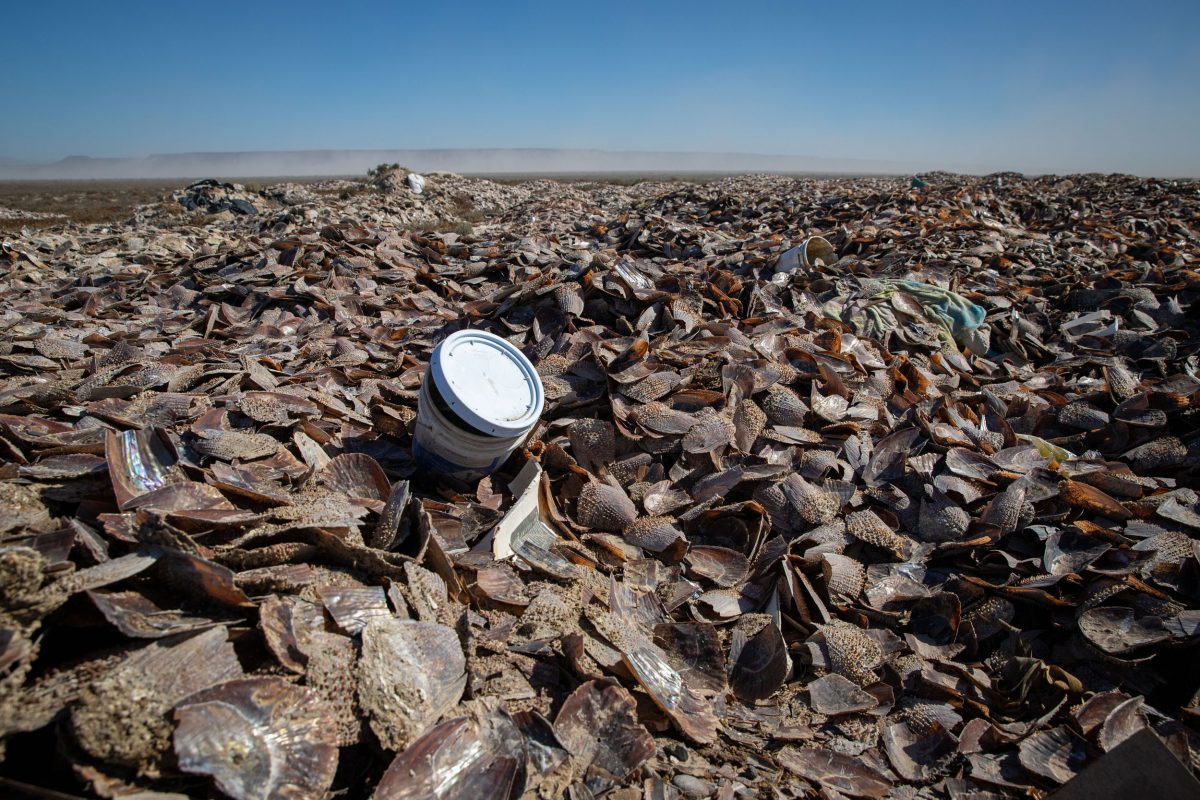
Tens of thousands of shells of callo de hacha, the pen shell clam, are piled deep surrounding the dump in Laguna San Ignacio. This species is one of several clams that form an important part of the income in this area. Many in El Delgadito, as the community is known by those who live there, believe that their children will not be able to make a living fishing as they have done. “We are taking and not putting back,” says one of El Delgadito’s fishermen.
Four species of mangroves—red, white, black, and sweet—grow throughout the state of Baja California Sur, which covers the lower half of the Baja California peninsula, and elsewhere in tropical and subtropical latitudes around the world. Mangroves are perhaps not what jumps to mind in desert ecosystems like that of El Delgadito, however, which sits less than one half of one degree south of all mangroves’ northern limit in the entire eastern Pacific. Mangroves here grow short and stunted compared with their tropical counterparts—even when fully developed, a species that reaches over 25 meters in height in the tropics may barely make two meters in this region. Their small stature doesn’t make them any less mighty from the standpoint of the ecological services they provide. Studies in Baja California Sur and the adjacent Gulf of California have shown that not only do fisheries landings increase in areas where there are more abundant mangroves but also that these mangroves match or even outperform tropical mangrove ecosystems in their carbon sequestration abilities.
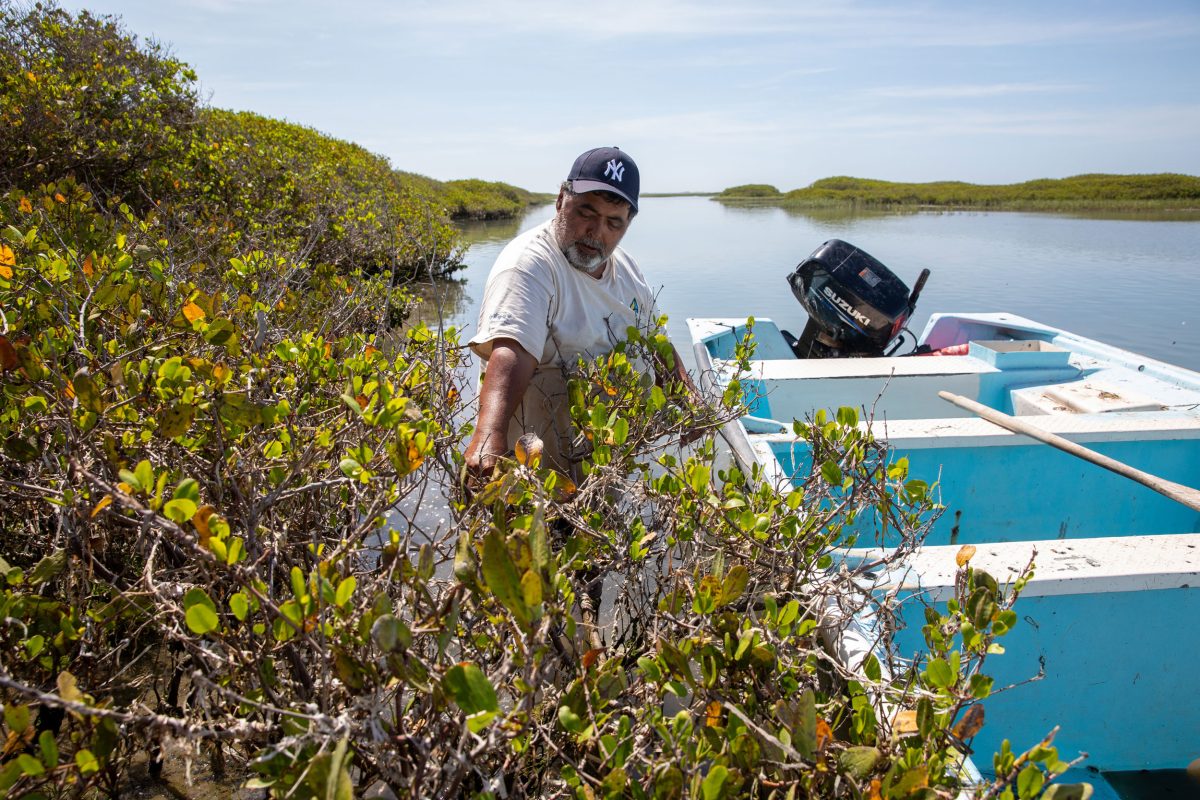
Borbón stops to clean debris off some of the oldest mangroves in the area, estimated to be around 250 years old. Shortly after learning about mangroves from his daughter, a serendipitous visit from a researcher doing her thesis project on the vulnerability and resilience of the mangroves on Baja California’s Pacific coast provided him an opportunity to understand more about the life cycles of the different mangrove species and the threats they are facing. When people in his community told him he was crazy for starting to plant mangroves, she offered encouragement. To this day, he still keeps a copy of her thesis in his home.

The “prop” roots of the red mangrove. Studies show that Baja California Sur’s desert mangroves grow on top of their own root remains, forming a type of peat that serves as a highly efficient environment for carbon sequestration. This peat extends to depths of more than three meters, and core samples indicate that, in some areas, it has been storing carbon at the same rate for over 5,000 years. It has also historically provided mangrove ecosystems in this region with a mechanism for keeping pace with sea level rise.
Baja California Sur is the least densely populated state in all of Mexico, and extreme loss of mangroves is concentrated in the urban spaces of La Paz and Los Cabos. Construction of fishing camps around El Delgadito in the 1980s led to the removal of some of the area’s mangroves, but nothing has done as much damage in recent years as climate change, says Borbón. Higher tides and stronger currents undercut the sandbars that support the mangroves, carving underwater caves that eventually cause the entire root system to collapse, especially among younger trees.
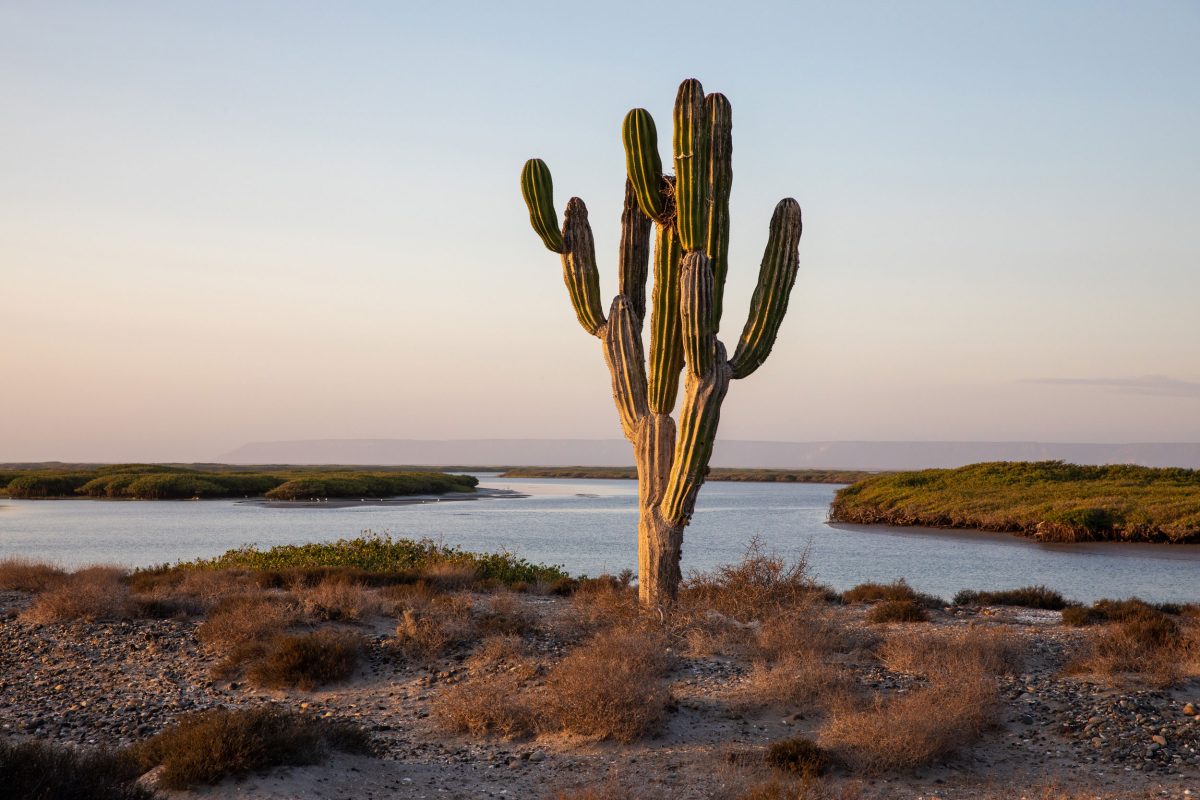
Mature mangroves in this desert ecosystem barely stand out in the background, size-wise. El Delgadito sits less than one half of one degree south of all mangroves’ northern limit in the entire eastern Pacific, making even these centuries-old trees look short and stunted. Although mangroves make up less than one percent of the terrestrial area of the Baja California peninsula, they store about 28 percent of the total below-ground carbon in this arid climate. This makes them by far the biggest carbon sink in the region, a feature that Borbón and his wife, Ana María Peralta, know will be monumental in tackling the local impacts of climate change.

Rising sea temperatures trigger mass die-offs of seagrasses, which are swept by the currents onto mangroves, often smothering them or ripping their young roots from the substrate. Borbón painstakingly removes these deposits both from trees he has planted and from those that have grown naturally.
Though never formally trained in the sciences, Borbón has an incredible aptitude and devotion toward experimentation. Taking what he knew from being raised in an agricultural region of Mexico, he carried out early iterations of his work growing mangroves in a greenhouse. He soon found that the young trees couldn’t handle the shock of being transplanted, so he and Peralta started “playing scientists,” as he calls it, planting propagules in the places surrounding El Delgadito where they ultimately wanted them to grow. Over the years, they have perfected the process to a point where they may very well know more than anyone else about growing mangroves in this desert ecosystem, though they never stop experimenting with new ideas.
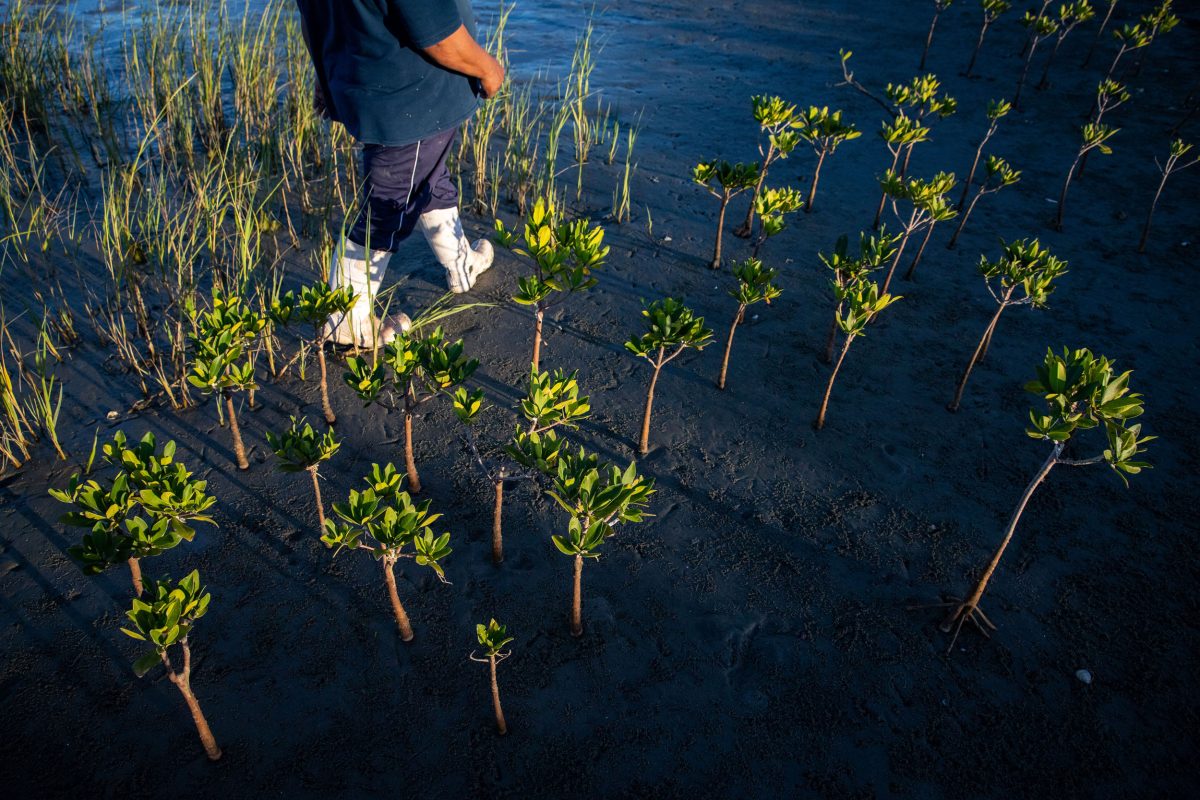
Borbón checks on some of his two-year-old trees. When he first started, he’d experiment with spacing between the plants as well as their distance from the high tideline. He also tested how wind, current, waves, and cardinal direction to these natural forces changed his success. “Do you know what the most important thing is?” he asks me. “Not science, not technology. Heart.”
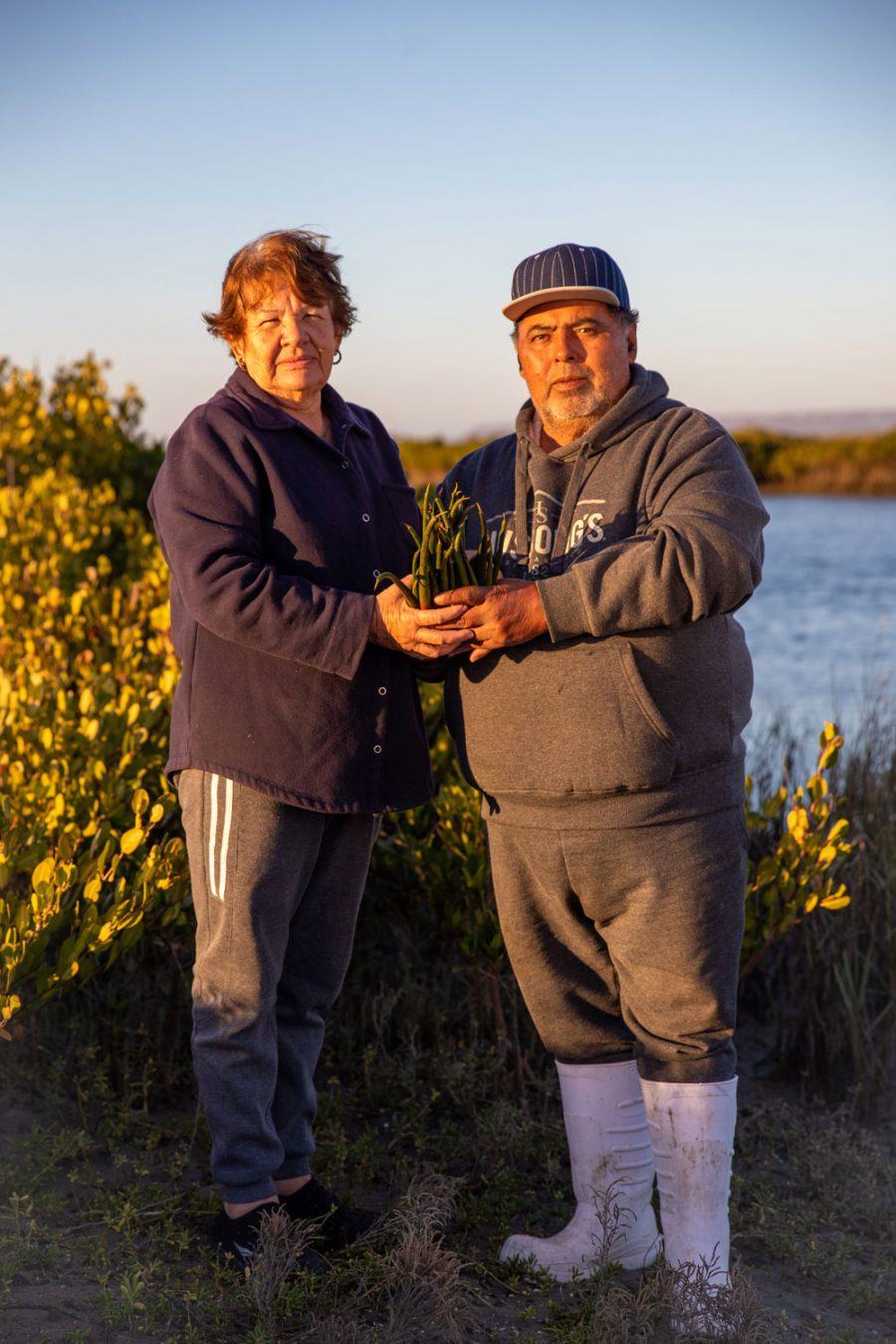
Peralta and Borbón with the mangroves across the dirt road from their home. In recent months, Borbón has been invited to present at international conferences, heard pitches from the World Bank, and been asked to begin a train-the-trainers program for others trying to restore mangroves in their communities. “We are not talking about sustainability,” he says, “we are talking about regeneration—and it’s worth fighting for, whatever is required, because it’s necessary. It’s very necessary in these communities to avoid emigration, to create opportunities for both young and old, for men and women, for people on the coast and people on ranches in the sierras [mountain ranges], because this is wonderful.”
Today, Borbón and Peralta have a team of over 20. It is paid work—the only of its kind in this area that isn’t from fishing. Funding now comes from partnership with a US-based environmental services company instead of from the couple’s own pocket. Their team members range in age from 19 to 60, though the majority are youth. “Our focus is more with the younger than the older generations,” explains Peralta. “You can’t change what they’re accustomed to. But the young people are learning. They’re the future of here, the future of Mexico, the future of everything, to continue with the mangroves.”
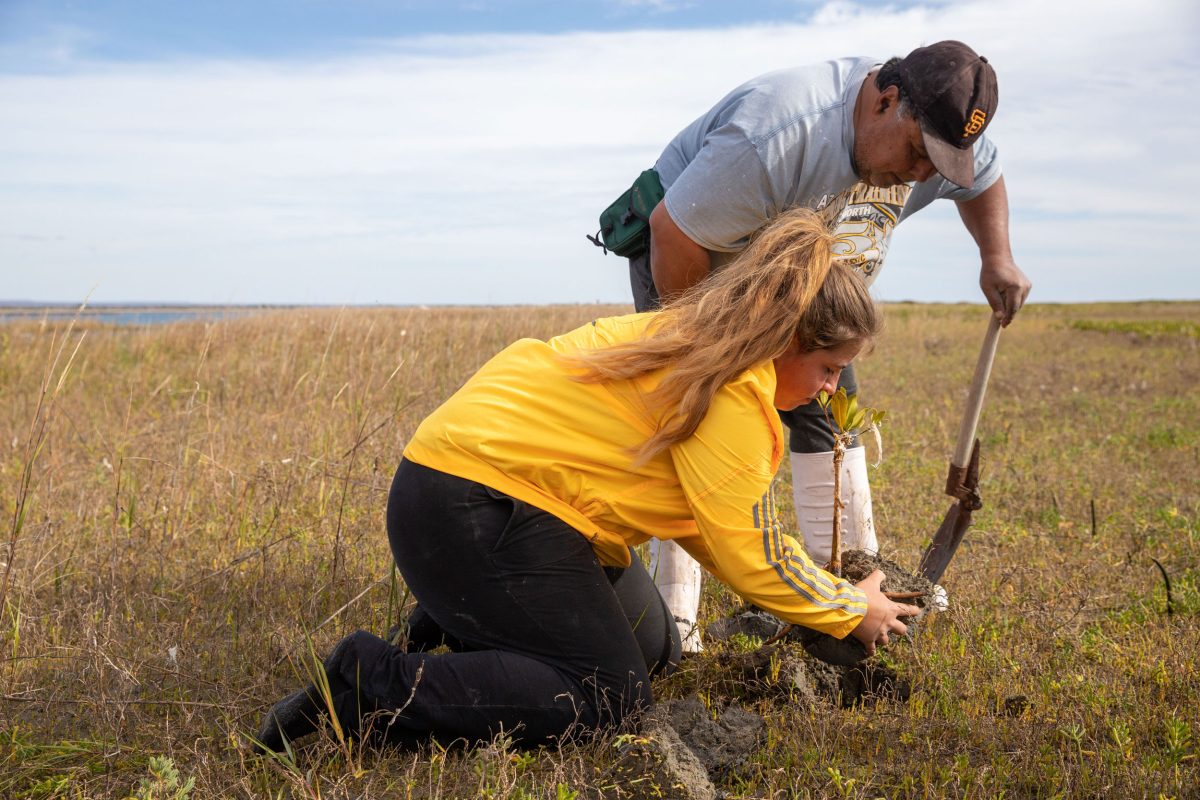
Borbón helps Victoria, one of his core team members, transplant a year-old mangrove. He is worried he planted last year’s trees too close together and is experimenting with moving them farther apart while they are still young. This year’s propagules will be placed farther apart from the get-go.

Borbón and Peralta soak the propagules for eight to 11 days in fresh water to stimulate the growth of root nodules. Then, with their team of young community members, they count the propagules and place them in buckets to take into the field, doing quality control along the way. Borbón has learned over the years that it’s best to target those that have developed to the point where they are still attached to the parent tree but fall off easily, like ripe fruit.
During the summer months, they take scouting trips to monitor the development of new red mangrove propagules and tend young trees. Come October, they harvest the propagules and soak them in fresh water for just over a week. At the restoration site, one person walks a transect line using a wooden tool to punch a small hole into the sediment while another follows with the propagules. It takes just a second to plant each one, and over the past 12 years they’ve planted an estimated 1.2 million and watched stretches of bare sand transform to green. It’s still too soon to see the impact on local fisheries, but Borbón has no shortage of hope: “The fact that we plant mangroves generates life. We expand the possibilities of helping nature by allowing them to naturally repopulate and recover.” He adds that the “constant attack” from fishing limits recovery, but he’s not deterred. “That is why it is so important that we continue with our efforts.”
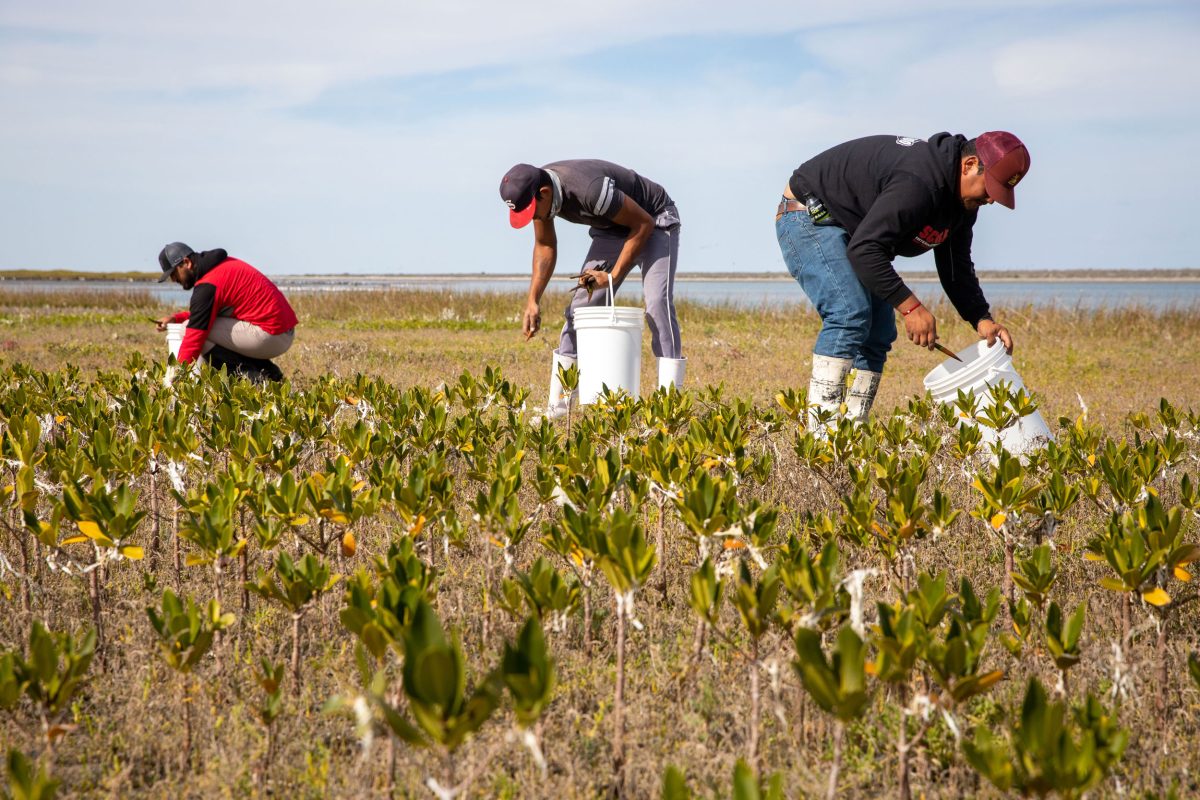
Working as a team, community members of El Delgadito plant new red mangrove propagules alongside one-year-old trees from last season’s work. Borbón and Peralta have found that, aside from the direct investment in mangroves, hiring youth also takes away some of the impact of local fisheries by providing people with an economic alternative. “We need jobs for young people. Because many can’t get an education, and they get married very young and want to do the same as their parents, they become fishermen and fish as much as they can. They need jobs, another type of work,” Peralta explains.
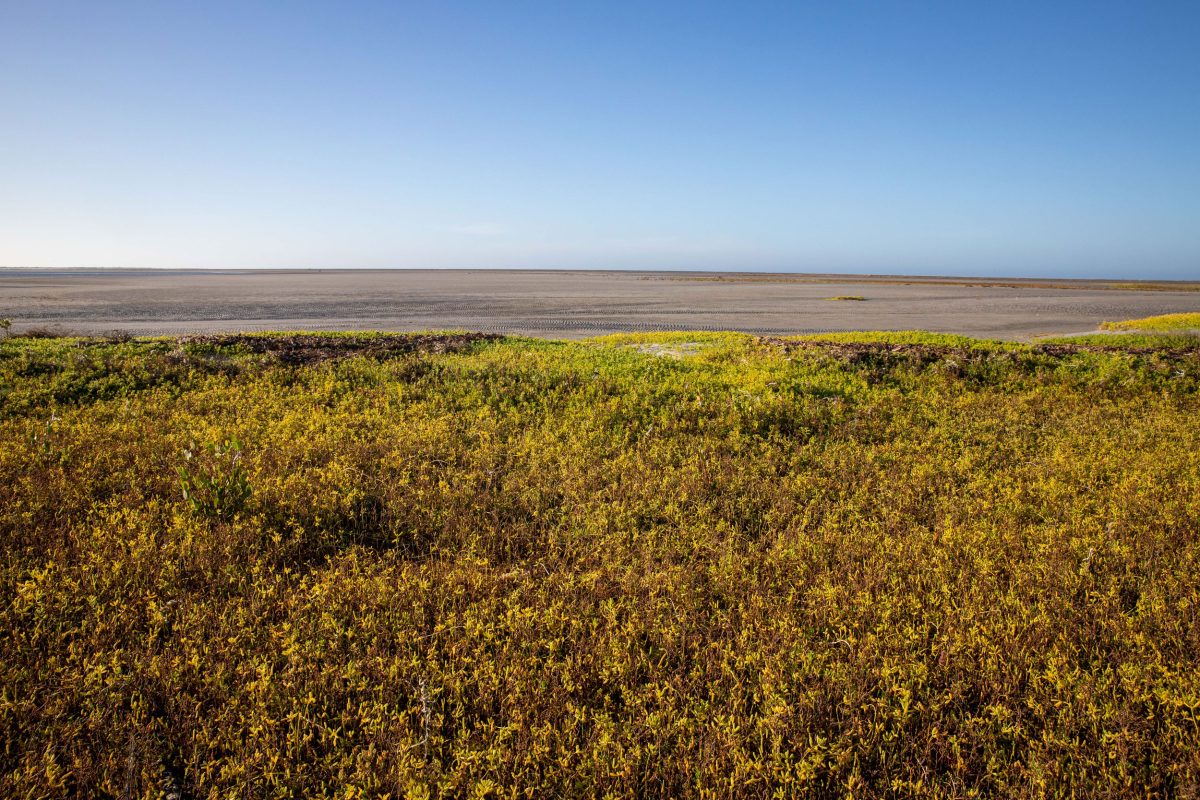
Areas that started as bare sand quickly developed vegetation once the young red mangroves stabilized the soil. Species like Salicornia and white mangroves sprout on their own, forming a cover of green.
In early September 2022, Hurricane Kay made landfall several hours north of El Delgadito. Colder surface waters on the Pacific coast of Baja California have historically made it rare for a storm system to make its way this far north along the peninsula. Mangroves have been shown to absorb 70 to 90 percent of a wave’s energy, and the storm put Borbón and Peralta’s work to the test. Areas that had their first mangroves planted 10 years prior were destroyed, leaving almost nothing but sand where the highest branches once reached overhead. The couple was devastated, and Borbón’s eyes filled with tears when he broke the news to me. He estimates that, in addition to those first trees he planted, close to 300,000 young trees were lost. Soon after, a marine biologist friend brought an impact assessment expert from the US National Oceanic and Atmospheric Administration to see El Delgadito. She looked at the proximity of the mangroves that had been destroyed to the community and told the couple that their work very likely prevented the loss of much of their community.
The researcher’s comments provided hope for the future and validation to Borbón and Peralta that their efforts weren’t for naught. Today, looking out from the driver’s seat in his small boat, Borbón envisions what is to come. “My dream for this region has no limits; what can be done is wonderful. We have dedicated ourselves to conservation because it is very clear to me that the day mangroves end, life ends in this region.” Tomorrow, he’ll wake at dawn and drink a cup of coffee before driving down the road to his boat, never missing a beat in his dedication to making his vision a reality.

